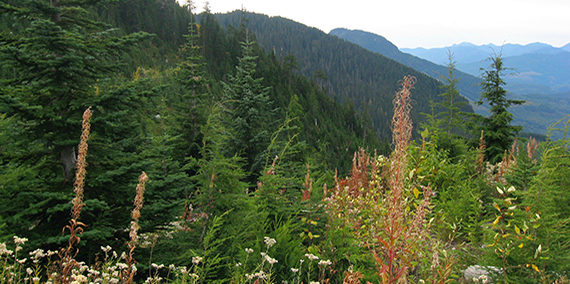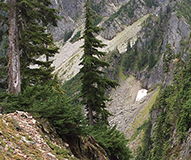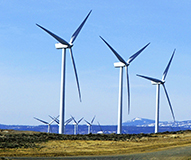Eligibility Determination

A Thorough Process
DNR examines each proposed parcel very carefully to determine if it is eligible for transfer through the Trust Land Transfer (TLT) program:
- DNR will verify that each parcel has a receiving agency who is willing and able to accept the parcel and manage it indefinitely.
- DNR will analyze the parcel to determine if the transfer is in the best interests of the trust beneficiaries. Proposed transfers that are not in the best interests of the trust beneficiaries or do not have a receiving agency will be removed from further consideration.
- DNR will conduct outreach to tribes and (if the parcel includes State Forestlands) affected counties and their taxing districts for all remaining parcels.
- DNR will make a final determination of eligibility based on all of the information gathered during this process.
What does DNR look for in a receiving agency?
DNR will ensure that the receiving agency is willing and able to accept the parcel. DNR will read the letter of intent from the receiving agency, review the parcel application, and contact the receiving agency with any questions.
How does DNR determine if a transfer is in the best interests of the trust beneficiaries?
DNR analyzes the nominated parcel to determine its revenue-generating potential. First, DNR will determine how the parcel is currently being used, and how much revenue (if any) those activities are generating. For example, DNR will check for planned, sold, or recently completed timber sales and leases for other revenue-generating activities, such as grazing or agriculture.
DNR also will examine each parcel through multiple lenses to assess its potential for generating revenue in the future. Following are a few examples of what DNR considers.
Physical factors
 DNR will consider topography, annual rainfall, and other physical factors that affect revenue-generating activities such as timber harvest. For example, steep, mountainous parcels at high elevations often have poor soils on which trees grow very slowly.
DNR will consider topography, annual rainfall, and other physical factors that affect revenue-generating activities such as timber harvest. For example, steep, mountainous parcels at high elevations often have poor soils on which trees grow very slowly.Operability
For forested parcels, DNR will determine the percentage of the parcel that can be harvested under state and federal laws and DNR policies. Examples of lands that cannot be harvested include streams and associated buffers, unstable slopes, forests defined as old growth per DNR’s Policy for Sustainable Forests, natural forests being managed as gene pool reserves, marbled murrelet occupied sites, and other sensitive areas.
Water rights and facilities
For agricultural properties, DNR will determine whether the parcel has water rights and facilities such as wells, water pipelines, or water storage tanks.
Access and surrounding area
DNR will determine if the parcel has road and legal access, or if DNR can attain access. DNR also will consider how transfer of the parcel could affect access to, or management of, adjacent state trust lands. In addition, DNR will consider other factors that could influence management, such as current public uses of the parcel, the parcel’s proximity to urban or residential areas, surrounding land uses, current zoning, and development trends in the local area.
Other opportunities
 DNR will consider whether the parcel can be managed for solar or wind power generation, or a different type of revenue-generating activity. In addition, DNR will determine whether the TLT program is the best option for repositioning the parcel. For example, some parcels can be sold or exchanged with another land owner.
DNR will consider whether the parcel can be managed for solar or wind power generation, or a different type of revenue-generating activity. In addition, DNR will determine whether the TLT program is the best option for repositioning the parcel. For example, some parcels can be sold or exchanged with another land owner.As part of this analysis, DNR will estimate the parcel's fair market value. Fair market value is based on the highest and best use of the property and includes the value of land, timber, other valuable materials, and improvements owned by the state.
Who performs tribal outreach?
DNR will reach out to affected tribes to gather their feedback and concerns about the transfer.
Why does DNR reach out to counties and taxing districts for State Forestland transfers?
The beneficiaries of State Forestlands are the counties in which these lands are located. When a timber harvest occurs, DNR provides the revenue to the county. The county distributes the revenue to individual taxing districts within the county according to RCW 79.64.110. Taxing districts are organizations that have the legal authority to impose property taxes to fund ports, schools, roads, parks, public transit, and other public services.
Because many taxing districts are small and depend heavily on trust revenue, they can be disproportionately impacted by transfers. For that reason, DNR does outreach with counties and taxing districts to gather their concerns about the transfer.
What happens next?
If a parcel is eligible for transfer, it will move on to the next step in the process, prioritization. For each eligible parcel, DNR will post the application package and a summary of the best interests of the trusts analysis on the proposed and current transfers page. DNR also will notify all successful applicants and receiving agencies (via email) that the nominated parcel is eligible for TLT, and that it will move to the next step, prioritization.
During prioritization, you will be asked to present your parcel to an advisory committee. Refer to the Prioritization page and the TLT Program Manual for more information.
If a parcel is not eligible for transfer, DNR will email you and explain why. If your application is not successful, you may improve and resubmit it for the subsequent biennium during that biennium's application period.

